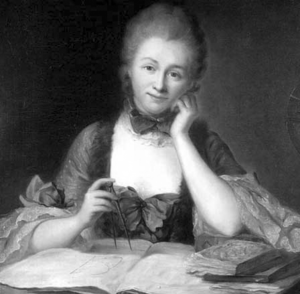Du Châtelet Rediscovered
I was delighted recently to discover two books and a play about a brilliant Enlightenment scientist whose importance has only recently been realized: Emilie Du Châtelet. She lived in France and produced her most important work between 1735 and 1749. She was a polymath, probably one of the brightest thinkers of her time. She made many original contributions to understanding heat and light, but she has been ignored and unknown until recently.

Du Châtelet’s greatest contributions to science were two monumental works: Institutions de physique (Foundations of Physics) and Commentaire on Newton’s Principia. In Institutions, she created a comprehensive and coherent synthesis of ideas about religion, philosophy, and the science of astronomy, heat, and motion that had been circulating. This was an ambitious undertaking that was more complete than anything Newton had attempted. Selecting ideas from Newton, Leibniz, Descartes, and many lesser known “natural philosophers” of the period, she created her own synthesis. Institutions was well received and earned her wide recognition as a leading philosopher.
Science of the Enlightenment was all mixed up with religion and politics. Truth was dictated by one’s homeland. You were either in the English Protestant Newton camp, or the French Catholic Descartes camp, or the German metaphysical Leibniz camp. Emilie Du Châtelet managed to transcend these divisions and combined the best ideas regardless of nationality and religion.
Du Châtelet’s Commentaire was also a bold effort that started as translating Newton’s Principia, but became an authoritative exposition of mechanics that was far more easily understood than the original and contained three important experimental verifications of Newton’s results that had been completed in the half-century since its publication. She also corrected errors, such as Newton’s assumption that the earth was homogeneous. But most importantly, she used the modern Leibniz calculus notation instead of Newton’s idiosyncratic and difficult fluxions. Because of nationalistic politics, English scientists rejected this improved approach, and her formulation put French physics ahead of England’s for two hundred years.
There was persistent confusion about heat at the time—whether it had mass, how it was stored and liberated, where it went, and how light and flame related to heat. The dominant theory stated that a substance called phlogiston was liberated by fire and flowed into other materials. It wasn’t until the 1780s that Lavoisier disproved phlogiston by burning materials in sealed containers. But the idea died hard.
Mulling over these issues, in 1737 Du Châtelet had the temerity to hold that light was massless, an extraordinary, original, and correct idea. She realized that light traveled extremely fast and reasoned that if it had mass, its impact on earth would be devastating. She also measured the heating caused by different colors of light and discovered that there was invisible light that could warm a thermometer, what we call infrared light.
Du Châtelet’s most celebrated original contribution was to identify energy with mv2 and to posit that energy was conserved, that one form of energy might be converted to another, but that the total energy was constant. This was a major break with Newton who focused on mv, a scalar quantity that he observed could disappear in a collision.
Her science alone should have earned her widespread recognition, but her unconventional love life overshadowed her science. Her brilliance made it inevitable that she and the second-best thinker of the time, Voltaire, became lovers for over a decade. He supported and inspired her, but also undercut her. When they first discovered each other, they collaborated on a translation of Newton that he published under his name, though her contributions appear to have overshadowed his.
Voltaire fancied himself an original scientist and entered a competition held by the French Academy on the nature of heat. He undertook extravagant but uncontrolled experiments to measure the mass of heat. She helped during the day and then wrote her own entry for the competition at night and secretly submitted it. They both won commendations, but hers would have won if she had been established and male.
Du Châtelet died at 42, her life cut short by a fatal pregnancy. Because she was a woman who died young, and because Voltaire and French society belittled her posthumously, her contributions have been almost invisible. The current explosion of interest in her has led to two important books and a brilliant play. Both books cover the many fascinating twists and turns of Emilie Du Châtelet’s life. Passionate Minds is shorter and quite absorbing, so I recommend it as a way to enter her world. The Zinsser book is more authoritative and provides far more detail.
“Legacy of Light” intertwines Du Châtelet’s story with that of a fictitious modern astrophysicist who is also a woman. The resulting tapestry is good theater, witty and memorable. The play moves deftly over time and space, combining riveting sketches with absorbing lectures about the culture and science.
Both scientists deal with the dual demands of science and the biological reality of conceiving and bearing children. Without preaching or moralizing, the play addresses these age-old issues head on, balancing the tragedy of Emilie Du Châtelet’s life with a more successful resolution in the present. The play also treats the science accurately and thoughtfully. Students interested in science would find it an accessible way to learn the process and some key ideas of science, and every young woman would find new role models in the play.
These publications mark the resurrection of Du Châtelet and her science. They begin to fill in a missing link in the history of science. She helped clarify the fuzzy thinking of the time at considerable personal cost. It is unfortunate that she cannot shine even today on the strength of her brilliance without being illuminated by the brighter flame of Voltaire, even though his science was far inferior.
